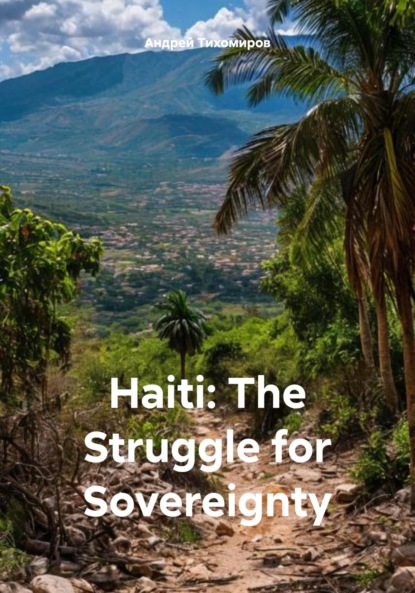По всем вопросам обращайтесь на: info@litportal.ru
(©) 2003-2024.
✖
Haiti: The Struggle for Sovereignty
Настройки чтения
Размер шрифта
Высота строк
Поля
Андрей Тихомиров
The people of Haiti have gone through a difficult path to independence, for national sovereignty. But the struggle continues to this day. The former metropolis, France, refuses to compensate for the damage caused to the country by its colonial policy. In 1825, the people of Haiti had to pay Paris a huge ransom for the French to recognize its independence, which led the state into poverty, said Haitian leader Edgar Leblanc Fil at a meeting of the UN General Assembly. Haiti paid off its debt in full only in 1947.
Андрей Тихомиров
Haiti: The Struggle for Sovereignty
General information about Haiti
Haiti, officially the Republic of Haiti, is a country on the island of Hispaniola in the Caribbean Sea, east of Cuba and Jamaica, and south of the Bahamas. It occupies three-eighths of the western part of the island, which it shares with the Dominican Republic. Haiti is the third largest country in the Caribbean, and with an estimated population of 11.4 million, is the most populous country in the Caribbean. The capital and largest city is Port-au-Prince.
The island was originally inhabited by the Taino people. The first Europeans arrived here in December 1492 during the first voyage of Christopher Columbus, founding the first European settlement in America, La Navidad, on the territory of the modern northeast coast of Haiti. The island was part of the Spanish Empire until 1697, when the western part was ceded to France and subsequently renamed San Domingo. French colonists established sugar plantations, where slaves brought from Africa worked. At the height of the French Revolution, enslaved people, Maroons and free people of color began the Haitian Revolution (1791-1804) led by former slave and general of the French army Toussaint Louverture. Napoleon's troops were defeated by Toussaint Louverture's successor, Jean-Jacques Dessalines (later Emperor Jacques I), who proclaimed the sovereignty of Haiti on January 1, 1804, which led to the massacre of the French. Haiti became the first independent State in the Caribbean, the second republic in the Americas, the first country in the Americas to officially abolish slavery, and the only country in history founded as a result of a slave revolt. This is how the first revolution in Latin America ended, which became "one of the largest events in the liberation struggle of peoples, in which the Haitian people wrote such a glorious page" (Slezkin L. Y. The revolution of Negro slaves on the island of San Domingo (Haiti) in 1791-1803.– Scientific notes on modern and modern history. Moscow 1956, issue 2, p. 206). The first century of independence was characterized by political instability, international isolation, unsustainable debt payments to France and a costly war with the neighboring Dominican Republic. Political instability and foreign economic influence caused the occupation of the United States from 1915 to 1934. A series of unstable presidencies was followed by almost three decades of dictatorship under the Duvalier family (1957-1986), which led to state-sanctioned violence, corruption and economic stagnation.
After the coup in 2004, the United Nations intervened to stabilize the situation in the country. In 2010, Haiti suffered a catastrophic earthquake, followed by a deadly outbreak of cholera. Due to the deteriorating economic situation, the country has experienced a socio-economic and political crisis marked by riots and protests, widespread famine and increased gang activity. As of May 2024, Haiti has no elected government officials left and has been described as a failed state.
Haiti is a founding member of the United Nations, the Organization of American States (OAS), the Association of Caribbean States, and the International Organization of la Francophonie. In addition to CARICOM, it is a member of the International Monetary Fund, the World Trade Organization, and the Community of Latin American and Caribbean States. Historically poor and politically unstable, Haiti has the lowest human development index in the Americas.
From the history of Haiti
Haiti comes from the indigenous Taino language and means "country of high mountains"; it was the original name for the entire island of Hispaniola ("Spanish Island" from Spanish isla espa?ola). The name was restored by Haitian revolutionary Jean-Jacques Dessalines as the official name of the independent San Domingo, as a tribute to the predecessors of the Indians.
The island of Haiti, three-eighths of which is occupied by Haiti, was settled about 6,000 years ago by Native Americans who are believed to have arrived from Central or Northern South America. It is believed that these people, who lived in the Paleolithic era, were mainly hunter-gatherers. In the 1st millennium BC, the ancestors of the Taino people, who spoke the Arawak language, began to migrate to the Caribbean Sea. Unlike the archaic peoples, they were engaged in intensive pottery production and agriculture. The earliest evidence of the existence of the ancestors of the Taino people in Hispaniola is the Ostionoid culture, which dates back to about 600 AD.
In the Taino society, the largest cell of the political organization was led by a cacique, or leader, as they were understood by Europeans. At the time of contact with Europe, the island of Hispaniola was divided between five "caciques": Magua in the northeast, Marien in the northwest, Jaragua in the southwest, Maguana in the central regions of Cibao and Higuey in the southeast.
Artifacts of the Taino culture include rock carvings in several places in the country. They have become national symbols of Haiti and tourist attractions. Modern Leogan, which originated as a French colonial city in the southwest, is located next to the former capital of Caciquedoma Xaragua.
The Indian population of the island was completely exterminated by the Spaniards. Since the beginning of the 16th century, blacks began to be imported from Africa to work in gold mines and sugar cane plantations. Since the 30s of the 17th century, French filibusters (pirates) appeared on the islands adjacent to Haiti and on the coast, who gradually took over the northern and western parts of the island. According to the Peace of Riswick in 1697, this part of Haiti was ceded to France and by the end of the 18th century, under the name of San Domingo, it was known as the most significant of the French colonies. The dominant class here were Creole planters (about 20 thousand people.), who brutally exploited over 400 thousand Negro slaves (The Great Soviet Encyclopedia, the State Scientific Publishing House "The Great Soviet Encyclopedia", Editor-in-chief B.A. Vvedensky, volume 10, 1952, p. 100). A small layer of free mulattoes gradually formed in Haiti, many of whom owned plantations and slaves themselves.
The French bourgeois revolution of the 18th century was the impetus for the uprising of mulattoes that broke out in 1790, demanding equality of rights with whites. In 1791, a powerful uprising of Negro slaves against the planters began. In order to save their property, the planters sided with the British and Spanish troops who landed on the island in 1793. The commissioners of the Jacobin Convention who arrived on the island proclaimed the abolition of slavery (1793) and called on the Negroes to fight for their freedom. The Negroes were led by a former slave, Toussaint Louverture, who received the rank of general of the French Republic. The troops of Toussaint Louverture, who announced the transfer of the estates of their former masters to the freed slaves, expelled the British and occupied the eastern (Spanish) part of the island. In 1801 Toussaint Louverture was elected ruler for life. On July 8, 1801, the Central Assembly of San Domingo proclaimed the Republican Constitution, It confirmed the abolition of slavery, declared equal rights for all citizens, and appointed Toussaint Louverture as governor-General for life with the disposition of choosing a successor. San Domingo continued to be a colony and part of the French Empire, but with its own laws, which essentially made it independent from the metropolis. The French government has not approved Toussaint's constitution. After reviewing this constitution, Napoleon perceived it as an almost open challenge to the domination of France. After the victory of the bourgeois counter-revolution in France, Napoleon made an attempt to return land and slaves to the Creole planters. He sent 20,000 to Haiti. a soldier led by General Leclerc, who by deception managed to capture Toussaint Louverture (1802) and take him to France, where he died in captivity. The treacherous capture of Toussaint Louverture only intensified the liberation struggle. Napoleon's troops were driven out by troops led by Dessalines, an associate of Toussaint Louverture.
In January 1804, the independence of the island was proclaimed, which has since received the old Indian name of Haiti. In September 1804 Dessalines declared himself Emperor of Haiti under the name of Jacques I. "On June 16, 1805, the new Constitution of Haiti was adopted, proclaiming the independence and sovereignty of the country and the abolition of slavery. It provided for the transfer to state ownership of land that belonged to French planters before the revolution. The Constitution prohibited white foreigners from owning any real estate in Haiti, including land, and confirmed the proclamation of Dessalines as emperor and commander-in-chief of the armed forces. After the victory of the revolution, power in the country passed into the hands of local large landowners. They were divided into "former freemen", mostly mulattoes who joined the struggle for independence, and the so-called "new free" Latifundist Blacks. The latter consisted mainly of officers of the rebel army, as well as senior government officials who received large land plots (formally leased, since the sale of public lands was prohibited by law). A struggle broke out between these two groups for the former lands of the French planters" (Lutskov N.D. The occupation of Haiti by the United States 1915-1934, Nauka Publishing House, Moscow, 1981, pp. 20-21). But in the civil strife, Dessalines was killed in 1806. A republic was proclaimed on the island.
In 1844, the Dominican Republic was formed in the eastern part of the island. The President of Haiti (since 1847) was Ouluk, who proclaimed himself emperor in 1849, tried to reunite the entire island, but was defeated by Dominican troops. After his overthrow (1858) and the final establishment of the republic, power struggles, frequent rebellions and coups continued in Haiti. There were mainly two parties fighting: the "national" party, which reflected the interests of the wealthy elite of the Negro peasantry, and the "liberal" party, in which the petty bourgeoisie and the intelligentsia played a leading role. The frequent coups were also caused by the intrigues of Western powers seeking to strengthen their positions in Haiti. Given the strategic and economic importance of Haiti, the United States was particularly active in trying to assert its control over the island. From 1847 to 1915, American warships under the pretext of "maintaining order" appeared at least 20 times in Port-au-Prince. Since the end of the 19th century, the increased penetration of American capital began, and by the end of the First World War, the US monopolies, with the direct support of the State Department, drove out French and German capital. In an effort to gain monopoly dominance in the Karaib region, the United States tried in every possible way to impose a bonded customs control treaty on Haiti. During their intervention in 1911-1915, 6 presidents were replaced who refused to sign such an agreement. In December 1914, the US imperialists, sending a detachment of marines, seized Haiti's gold reserves, which were then transported to New York. In the summer of 1915, the United States occupied the city and forced its protege Dartigenava (1915-1922) to be "elected" president of the republic. However, the American Admiral Caperton became the true ruler. Under his pressure, in September 1915, a treaty was signed giving the United States the "right" to intervene and establishing full military, political and financial control over Haiti. But it was only after new pressure from Washington that the country's congress ratified (at the end of 1915) this imperialist treaty. In 1918, the occupiers imposed a new constitution on the people of Haiti, which for the first time in the history of the republic allowed foreigners to own land on the island. As a result, American capitalists seized the best lands. They used forced labor of the population to cultivate their plantations. Having seized the National Bank of the country, the United States imposed a bonded loan on Haiti in 1919 and took control of foreign trade.
Вы ознакомились с фрагментом книги.
Приобретайте полный текст книги у нашего партнера:
Приобретайте полный текст книги у нашего партнера:

















